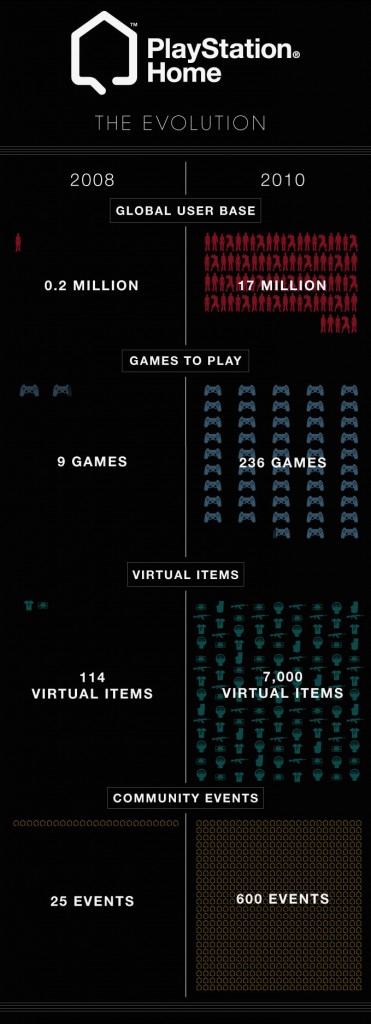Bigyama, and the Challenge of Branding Oneself
Video provided by Dan Schuller, Bigyama; commentary by NorseGamer, HSM Editor-in-Chief
The most successful development houses in Home have a brand identity that the consumer can easily grasp. LOOT, for instance, is where you go for commodities that break the fourth wall and narrow the gap between the real world and the virtual world. Hellfire Games is a clinic on how to run successful freemium games in Home. nDreams is Home put through Terry Gilliam’s funhouse mirror. Heavy Water is where you go for edgy tattoos and designs (and, soon, a lot more). Juggernaut is the land of crazy people who come up with awesome stuff that’s so advanced it seems like it’s from the future of Home. And Lockwood, of course, is simply better at everything.
It is thus fascinating to watch how a new developer tries to establish itself in Home.
It can’t be easy. On one hand, Home itself is way more sophisticated than it used to be. I know a lot of people love to lament the loss of various glitches from the old days, but from a development standpoint, those glitches should have never existed. Glitches mean amateur-hour coding that limit what you can do when building a game on the engine. And, under the bonnet, Home has evolved considerably in the last few years. So there are more tools for developers to play with (such as multiplayer APIs, courtesy of Home 1.5).
 On the other hand, the marketplace is a lot more crowded than it used to be. If we rewind the clock, say, just twenty-four months, how many developers disappear from the Home radar? The ones who got in early have quite a head start in establishing themselves. They built up cash flow and brand awareness in a less competitive marketplace. I imagine it has to be somewhat daunting for a newcomer to try to break into the scene today.
On the other hand, the marketplace is a lot more crowded than it used to be. If we rewind the clock, say, just twenty-four months, how many developers disappear from the Home radar? The ones who got in early have quite a head start in establishing themselves. They built up cash flow and brand awareness in a less competitive marketplace. I imagine it has to be somewhat daunting for a newcomer to try to break into the scene today.
It can be done, of course. Within the world of Home community media, HSM itself is a testament to this. We were comparatively late on the scene, at a time when a lot of major players were already established. We had to work longer and harder than everyone else, delivering a product no one else could, in order to establish ourselves. And it paid off. Today, thanks to our partnerships with the HomeCast and AlphaZone4 (the former being one of only two in-world sources of news and the latter being the most-visited Home community site in the world), we’re in a pretty outstanding position.
Which is why it’s so fascinating to watch how a new developer chooses to establish itself.
Bigyama hasn’t had the best of luck with its timing so far. Its highly-anticipated debut, the Forthstar clothing line, came out in the last week of May — which meant that it didn’t have enough time to rack up sales figures to even stand a chance of cracking the top-ten sales list — and the spotlight had already moved on by the time June rolled around. And now, as they announce their new furniture lineup, they’re up against VEEMEE’s release of No Man’s Land, one of the biggest games ever released into Home.
This is a shame, because the Forthstar clothing really is quite excellent; it’s sort of a Firefly-inspired, spaghetti-western-in-space feel. It’s the closest you can get to replicating Leiji Matsumoto’s Gun Frontier in Home. And this latest furniture offering from Bigyama is worthy of note as well.
Starting off with clothing and furniture is the safe and predictable route for a new developer to choose. They’re faster and less expensive to develop, providing a good cashflow baseline to work with, and it allows you to generate a bit of a brand presence before launching into something big. Granted, not every developer takes this approach — Juggernaut, for instance, exploded on the scene with the Cutteridge Estate, which was wildly successful — but in general it’s not a bad idea for a startup to hedge its bets.
Take a look at the video of the new Bigyama furniture:
Here’s what’s particularly fascinating about this lineup: it’s limited to chairs, sofas, tables and the occasional ottoman.
In other words, it’s limited to what people actually have the greatest tendency to buy.
This is very, very smart. Rather than offer one motif with tons and tons of items that might or might not sell, they developed multiple variations of the same items. Somebody’s been doing their homework. After all, what tends to sell the best? The items you really need: chairs, tables and sofas. Those are the statement pieces.
I have a confession to make. I haven’t bought a piece of furniture in over a year. There just hasn’t been a need. Once I got my Paris Classical and Waterfall Terrace bundles, I was set. As far as I’m concerned, every setting should look like it came from the pages of Robur-le-Conquérant. So there just hasn’t been any need for me to invest in furniture which doesn’t aesthetically appeal to me.
Bigyama’s got a great strategy here. By limiting their furniture to the items which sell in the greatest numbers, and then spreading them out across multiple motifs, they’re more likely to appeal to a broader selection of consumers. Someone might look at the lineup and think, well, I don’t like the Jefferson Collection, but man, that Zen Collection really hits me! And boom, there’s a sale.
As for me? I’m buying that Oslo Collection. Big surprise there, right? And yet it is surprising, at least for me, because I really didn’t think I was going to be buying any more furniture any time soon. But Bigyama has successfully sold me.
Pay attention to Bigyama. This is a developer worth keeping an eye on. They’re releasing great virtual commodities and they’re clearly being smart with their business plan. I’m rooting for them.



 LinkedIn
LinkedIn Twitter
Twitter
Wow cool! I am an avid decorator- this has me giddy with anticipation
I think it is nice that they came out with several choices instead of just one style at a time. Good thinking if you want to establish yourself quicker.
While they are indeed hitting a market that’s already stuffed full, there’s certianly room for improvement, and they could bring that if they pay attention. Sure it’s gonna be hard to get noticed since LW and Loot etc already have Home in the choke-hold, but all BigYamma have to do is look and learn from the mistakes that have already been made. I mean look at (umm, no offence!) MyDeco; they’ve described their products wrongly (apparently unintentionally) with things in the past, and I have to say, the majority of their stuff is kinda sub-standard. Anyway, enough MyDeco bashing (sorry guys, just one Internet-nerds opinion), BigYammas clothing (although I never bought any) were of obviously good stock, the quality shows. IF (big “if” there) they can bring more animations to the seats they’d pull WAY ahead of the competition. Want an example of this then I place my bets on those new beds as big sellers.
Again, sorry for the MIGHTY WAAALL OF TEXT! lol
yeah yeah oh please fix that flippen glitch that has me going through the backs of furniture when I talk- that is so god forsaken irritating. And darn it, it would be so nice lean to one side against an arm rest… or even OMG! lay down on a couch…